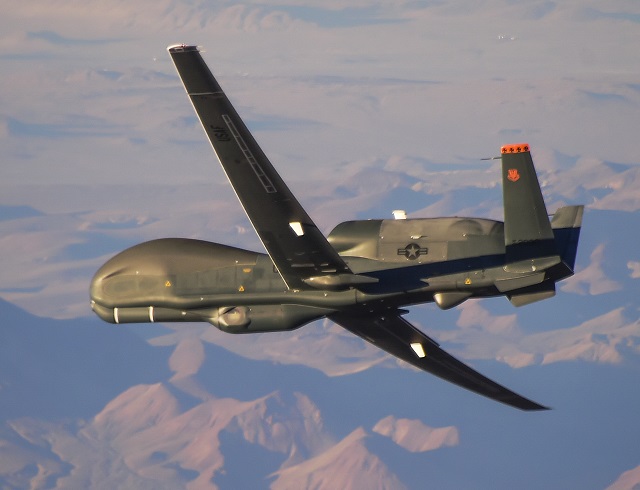Northrop Grumman has installed the UTC MS-177 multispectral sensor on board its RQ-4 Global Hawk unmanned air vehicle, and plans to carry out the maiden flight of the payload on the type in coming days.
Mick Jaggers, vice-president and programme manager for the RQ-4, tells FlightGlobal that the sensor was received in early December following a series of laboratory tests, and he expects the first flight to take place “next week” at the company’s Palmdale facility in California.
MS-177 is the next generation of the Senior Year Electro-optical Reconnaissance System-2 (SYERS-2), a sensor that is carried on the Lockheed Martin U-2 Dragon Lady manned high-altitude surveillance aircraft.
The Global Hawk is set to replace the U-2 in this long-endurance surveillance role, and integration of the new sensor is part of that transition. A February demonstration saw SYERS-2 flown aboard the RQ-4 during a test flight at Palmdale, while the U-2’s Optic Bar Camera has also been flown, Northrop announced in October.
The Global Hawk will be the first aircraft to fly operationally with the MS-177, Jaggers says. The General Atomics Aeronautical Systems Predator C Avenger carried out sensor during flight trials of MS-177 earlier this year, but there is no operational contract related to this. A 2011 test also saw the Northrop E-8C Joint Surveillance Target Attack Radar System carry the sensor.
“We will operationalise the MS-177 so that the United States Air Force can declare initial operational capability for that sensor system by the end of 2017,” he adds.
“In this particular test we’ll test how the air vehicle accommodates for new weight and new centre of gravities, and then we’ll start demonstrating the recording and dissemination of the ISR [intelligence, surveillance and reconnaissance] information.”

Global Hawk testing the SYERS-2
Northrop Grumman
The first iteration of the MS-177 will be a seven-band multispectral system, but development of a 10-band hyperspectral MS-177 system is also under way. Initial operational capability will be achieved with the seven-band sensor, while full operational capability (FOC) will be achieved with the 10-band.
Following this first flight trial, the MS-177 will be tested for the next six months, after which the 10-band system will begin integration.
“We’ll start integrating that 10-band sensor at the beginning of 2018 for six months, and at the end of 2018 or so the United States Air Force will have the ability to start declaring FOC by October 2019,” says Jaggers.
Meanwhile, the company’s RQ-4-derived Euro Hawk UAV that it developed for the German air force has been taken out of storage and is undergoing maintenance.
Despite the programme having been mothballed in light of Berlin’s financial and political problems, a decision was made to try to return the air vehicle to flight.
A contract for this has not yet been signed, but Northrop is hoping it will happen, and if it does soon, the air vehicle could be airborne again in 2017.
“That’s going well,” Jaggers says, adding: “There have been very productive conversations with the German government.”
Airworthiness is still very much on the agenda for Germany, Jaggers notes, and he is confident that previous trials carried out by Northrop in his area will help prove the integration case for Euro Hawk.
Source: FlightGlobal.com



















